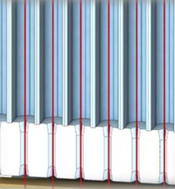A new detector for D20
The high intensity available on the D20 powder diffractometer allows diffraction studies to be performed as a function of time, temperature, magnetic or electrical field, pressure or gas composition, etc. The critical component of this workhorse instrument is its large “banana” 1D position-sensitive detector, operational since 2000; this detector consists of a curved pressure vessel – and hence its name - containing active elements called MSGC (micro-strip gas chambers); these are made of glass plates onto which chromium strips have been engraved by photolithography. The short distance of 0.4 mm between the anode and cathode strips enables the rapid recombination of the positive ions produced during the avalanches. This minimises the space charge effect in the amplification region, providing high local counting rate capability. More detailed information about MSGCs can be found in [1] and [2]. This technique was invented by Anton Oed at the ILL in 1988 for D20, and is at the origin of a decisive step in the development of radiation detectors in high energy physics. The Oed Prize was created in 2019 and rewards innovative development in the field of micro-pattern gas detectors (MPGD) [3]. The D4 and D20 powder diffractometers are the 2 main instruments using this technology. D4 consists of 9 MSGCs, mounted in independent pressure vessels filled at 15 bars, whereas D20 has 48 MSGCs mounted in a single pressure vessel filled at 4 bars.
The continuous sensitive area of D20 provides a significant advantage for data collection compared to modular configurations, but this comes at the cost of higher technical risk: the whole D20 detector would have to be switched off, if, for example, an anode-cathode short-circuit occurred. Fortunately enough this is very unlikely, but given its potentially dramatic impact on D20, combined with the fragile production base of MSGCs (IMT in Switzerland being the only company now producing them) alternative techniques are being explored.
At the ICNS conference in 2017 we presented the preliminary results obtained with a new detector developed for the XtremeD instrument [4]. Its name, the trench-MWPC, reflects its geometry of anode wires inserted into cathode trenches. As the electrostatic force applied on the anode wires is less than in standard MWPCs, there is a gain in stability resulting in more uniform detector response, even when long wires are used. The alternation of anode wires and cathode blades in the same plane provides an effect similar to that in MSGCs, in terms of a reduction in the space charge effect. The local counting rate measured with the XtremeD prototype is at least 5 times higher than with an equivalent MWPC.
 |  |  |
Fig 1: The trench-MWPC in study for D20: The main part of the detector will be made of 25 Aluminium cathode blocks machined to high precision using wire spark erosion. Photos (left and middle, credit JC Buffet) show two of these cathode blocks mounted side by side. The anode wires are run through the cathode trenches at a pitch of 2.5 mm using ceramic combs (right) | ||
In order to dispose of a spare detector solution for D20, a trench-MWPC prototype was built and mounted inside the old D20 detector prototype, replacing the MSGCs. Figure 2 shows the gain measured with an Am-Be source G as a function of high voltage.
 |
| Figure 2: Gain curve of the D20 trench-MWPC prototype (vertical axis in arbitrary units). A high voltage of 800 V between the anode wires and cathode trenches allows neutrons to be detected with 100% trigger efficiency. The detector was tested up to 1600 V, corresponding to a gain 1000 higher than that required to detect neutrons |
The high voltage required to detect neutrons in normal operation is 800 V; we tested the detector at 1600 V over several hours and encountered no problems. The gain at 1600 V is 3 orders of magnitude higher than at 800 V. This is a good indication of high robustness.
The counting rate curve was measured on the CT2 instrument with a collimated beam of 7 mm x 7 mm. Different thicknesses of plexi attenuator were installed 2 metres upstream of the detector. The 10% deviation from the fit in Figure 3 corresponds to the usual definition of the maximum counting rate. The measured value of 300 kHz corresponds to 100 kHz/channel and 6 kHz/mm2, exceeding the specification of D20 (50 kHz/channel).
|
|
Figure 3: counting rate measurement on the CT2 instrument. The neutron beam was 7 mm x 7 mm. |
The most critical part in the trench-MWPC is the cathode. It is machined in the ILL’s mechanical workshop with a wire spark erosion machine. Anode wires are inserted along the centre of the cathode trenches with a precision of 50 micrometres, using a metrology system based on a numerical microscope.
Although no feedback is yet available from trench-MWPC detectors operational on real instruments, the results already obtained with the XtremeD detector and the D20 prototype show that the trench-MWPC technique provides a robust and high-performance alternative to the old MSGC detector on D20.
References
1. Microstrip Gas Chambers (MSGC) for Future Neutron Instrumentation, Neutron News (2005), 16:4, 16-21, DOI: 10.1080/10448630500454445
2. https://sine2020.eu/about/the-road-to-the-ess/msgcs.html
3. https://www.ill.eu/news-press-events/news/general-news/a-tribute-to-anton-oed/

